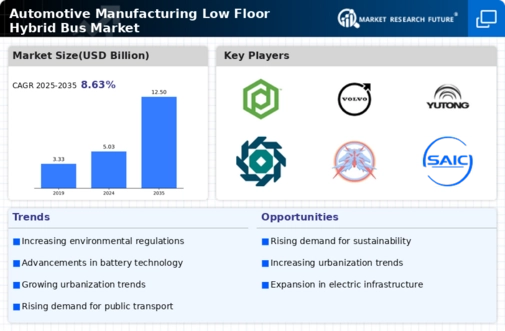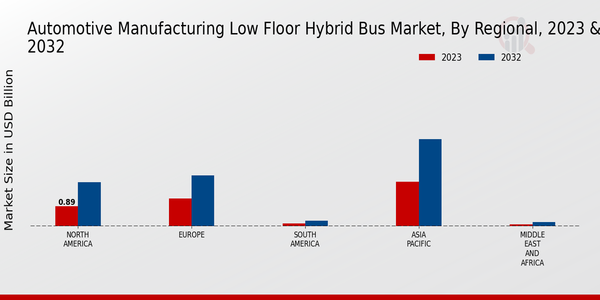Market Growth Projections
The Global Automotive Manufacturing Low Floor Hybrid Bus Market Industry is poised for substantial growth, with projections indicating a market value of 5.03 USD Billion in 2024 and an anticipated increase to 12.5 USD Billion by 2035. This growth trajectory suggests a robust demand for low floor hybrid buses, driven by various factors such as urbanization, government regulations, and technological advancements. The expected CAGR of 8.62% from 2025 to 2035 further underscores the potential for expansion within this market. As cities continue to invest in sustainable public transportation solutions, the low floor hybrid bus segment is likely to thrive.
Focus on Environmental Sustainability
The increasing focus on environmental sustainability is shaping the Global Automotive Manufacturing Low Floor Hybrid Bus Market Industry. As climate change concerns escalate, cities are prioritizing the reduction of greenhouse gas emissions. Low floor hybrid buses, which combine traditional fuel with electric power, offer a viable solution for reducing urban air pollution. Many municipalities are adopting green public transport policies, leading to a higher demand for hybrid buses. This shift towards sustainability is not only beneficial for the environment but also aligns with the growing consumer preference for eco-friendly transportation options, thereby driving market expansion.
Government Initiatives and Regulations
Government initiatives aimed at promoting sustainable transportation are significantly influencing the Global Automotive Manufacturing Low Floor Hybrid Bus Market Industry. Many countries are implementing stringent emission regulations and offering incentives for the adoption of hybrid vehicles. For instance, various governments are investing in infrastructure to support electric and hybrid buses, which enhances their appeal. These regulations not only encourage manufacturers to innovate but also stimulate consumer interest in environmentally friendly transportation options. As a result, the market is projected to grow at a CAGR of 8.62% from 2025 to 2035, reflecting the positive impact of these initiatives.
Growing Demand for Public Transportation
The Global Automotive Manufacturing Low Floor Hybrid Bus Market Industry is experiencing a surge in demand for public transportation solutions. Urbanization trends indicate that more people are moving to cities, necessitating efficient public transit systems. Low floor hybrid buses, with their accessibility features, cater to a diverse range of passengers, including the elderly and disabled. This growing demand is reflected in the projected market value, which is expected to reach 5.03 USD Billion in 2024. As cities strive to reduce congestion and pollution, the adoption of low floor hybrid buses is likely to increase, further driving market growth.
Rising Fuel Prices and Operational Costs
Rising fuel prices and operational costs are compelling transit authorities to explore more economical transportation solutions, thereby influencing the Global Automotive Manufacturing Low Floor Hybrid Bus Market Industry. Hybrid buses, which utilize a combination of fuel and electric power, can significantly reduce fuel consumption and operational expenses. As fuel prices continue to fluctuate, the economic advantages of hybrid buses become increasingly appealing to public transport operators. This trend is expected to drive the adoption of low floor hybrid buses, as they offer a cost-effective alternative to traditional diesel buses, enhancing their market presence.
Technological Advancements in Hybrid Systems
Technological advancements in hybrid systems are a pivotal driver for the Global Automotive Manufacturing Low Floor Hybrid Bus Market Industry. Innovations in battery technology, energy management systems, and vehicle design are enhancing the efficiency and performance of hybrid buses. For example, improvements in lithium-ion batteries are leading to longer ranges and reduced charging times, making hybrid buses more attractive to transit authorities. As these technologies continue to evolve, they are expected to lower operational costs and improve the overall user experience. This trend is likely to contribute to the market's growth, with an anticipated value of 12.5 USD Billion by 2035.

























